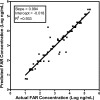Pharmacokinetic-pharmacodynamic assessment of faropenem in a lethal murine Bacillus anthracis inhalation postexposure prophylaxis model
- PMID: 20145081
- PMCID: PMC2863661
- DOI: 10.1128/AAC.00737-08
Pharmacokinetic-pharmacodynamic assessment of faropenem in a lethal murine Bacillus anthracis inhalation postexposure prophylaxis model
Abstract
There are few options for prophylaxis after exposure to Bacillus anthracis, especially in children and women of childbearing potential. Faropenem is a beta-lactam in the penem subclass that is being developed as an oral prodrug, faropenem medoxomil, for the treatment of respiratory tract infections. Faropenem was shown to have in vitro activity against B. anthracis strains that variably express the bla1 beta-lactamase (MIC range, <or=0.06 to 1 microg/ml). In this study we evaluated the pharmacokinetic-pharmacodynamic (PK-PD) relationships between the plasma faropenem free-drug (f) concentrations and efficacy against B. anthracis in a murine postexposure prophylaxis inhalation model. The plasma PKs and PKs-PDs of faropenem were evaluated in BALB/c mice following the intraperitoneal (i.p.) administration of doses ranging from 2.5 to 160 mg/kg of body weight. For the evaluation of efficacy, mice received by inhalation aerosol doses of B. anthracis (Ames strain; faropenem MIC, 0.06 microg/ml) at 100 times the 50% lethal dose. The faropenem dosing regimens (10, 20, 40, and 80 mg/kg/day) were administered i.p. at 24 h postchallenge at 4-, 6-, and 12-h intervals for 14 days. The sigmoid maximum-threshold-of-efficacy (E(max)) model fit the survival data, in which the free-drug area under the concentration-time curve (fAUC)/MIC ratio, the maximum concentration of free drug in plasma (fC(max))/MIC ratio, and the cumulative percentage of a 24-h period that the free-drug concentration exceeds the MIC under steady-state pharmacokinetic conditions (f %T(MIC)) were each evaluated. Assessment of f %T(MIC) demonstrated the strongest correlation with survival (R(2) = 0.967) compared to the correlations achieved by assessment of fAUC/MIC or fC(max)/MIC, for which minimal correlations were observed. The 50% effective dose (ED(50)), ED(90), and ED(99) corresponded to f %T(MIC) values of 10.6, 13.4, and 16.4%, respectively, and E(max) was 89.3%. Overall, faropenem demonstrated a high level of activity against B. anthracis in the murine postexposure prophylaxis inhalation model.
Figures





Similar articles
-
Pharmacokinetics-pharmacodynamics of gatifloxacin in a lethal murine Bacillus anthracis inhalation infection model.Antimicrob Agents Chemother. 2007 Dec;51(12):4351-5. doi: 10.1128/AAC.00251-07. Epub 2007 Sep 17. Antimicrob Agents Chemother. 2007. PMID: 17875992 Free PMC article.
-
Activity of dalbavancin against Bacillus anthracis in vitro and in a mouse inhalation anthrax model.Antimicrob Agents Chemother. 2010 Mar;54(3):991-6. doi: 10.1128/AAC.00820-09. Epub 2010 Jan 4. Antimicrob Agents Chemother. 2010. PMID: 20047912 Free PMC article.
-
Efficacy of oritavancin in a murine model of Bacillus anthracis spore inhalation anthrax.Antimicrob Agents Chemother. 2008 Sep;52(9):3350-7. doi: 10.1128/AAC.00360-08. Epub 2008 Jul 7. Antimicrob Agents Chemother. 2008. PMID: 18606841 Free PMC article.
-
Postexposure Prophylaxis and Treatment of Bacillus anthracis Infections: A Systematic Review and Meta-analyses of Animal Models, 1947-2019.Clin Infect Dis. 2022 Oct 17;75(Suppl 3):S379-S391. doi: 10.1093/cid/ciac591. Clin Infect Dis. 2022. PMID: 36251546 Free PMC article.
-
Faropenem medoxomil.Ann Pharmacother. 2008 Jan;42(1):80-90. doi: 10.1345/aph.1G232. Epub 2007 Dec 19. Ann Pharmacother. 2008. PMID: 18094341 Review.
Cited by
-
New developments in vaccines, inhibitors of anthrax toxins, and antibiotic therapeutics for Bacillus anthracis.Curr Med Chem. 2011;18(33):5083-94. doi: 10.2174/092986711797636036. Curr Med Chem. 2011. PMID: 22050756 Free PMC article. Review.
-
A Faropenem, Linezolid, and Moxifloxacin Regimen for Both Drug-Susceptible and Multidrug-Resistant Tuberculosis in Children: FLAME Path on the Milky Way.Clin Infect Dis. 2016 Nov 1;63(suppl 3):S95-S101. doi: 10.1093/cid/ciw474. Clin Infect Dis. 2016. PMID: 27742640 Free PMC article.
-
Development of a penem antibiotic against Mycobacteroides abscessus.Commun Biol. 2020 Dec 7;3(1):741. doi: 10.1038/s42003-020-01475-2. Commun Biol. 2020. PMID: 33288821 Free PMC article.
-
Central Nervous System Antimicrobial Exposure and Proposed Dosing for Anthrax Meningitis.Clin Infect Dis. 2024 Jun 14;78(6):1451-1457. doi: 10.1093/cid/ciae093. Clin Infect Dis. 2024. PMID: 38412060 Free PMC article.
-
Optical Screening for Rapid Antimicrobial Susceptibility Testing and for Observation of Phenotypic Diversity among Strains of the Genetically Clonal Species Bacillus anthracis.J Clin Microbiol. 2017 Mar;55(3):959-970. doi: 10.1128/JCM.02209-16. Epub 2017 Jan 4. J Clin Microbiol. 2017. PMID: 28053211 Free PMC article.
References
-
- Beharry, Z., H. Chen, V. R. Gadhachanda, J. D. Buynak, and T. Palzkill. 2004. Evaluation of penicillin-based inhibitors of the class A and B beta-lactamases from Bacillus anthracis. Biochem. Biophys. Res. Commun. 313:541-545. - PubMed
-
- Black, J. A., E. Smith Moland, T. J. Lockhart, P. D. Lister, and K. S. Thomson. 2001. Faropenem: activity against ESBL, AmpC, and other β-lactamase-producing Enterobacteriaceae, abstr. E-791. Abstr. 41st Intersci. Conf. Antimicrob. Agents Chemother. American Society for Microbiology, Washington, DC.
MeSH terms
Substances
LinkOut - more resources
Full Text Sources
Medical
Miscellaneous

